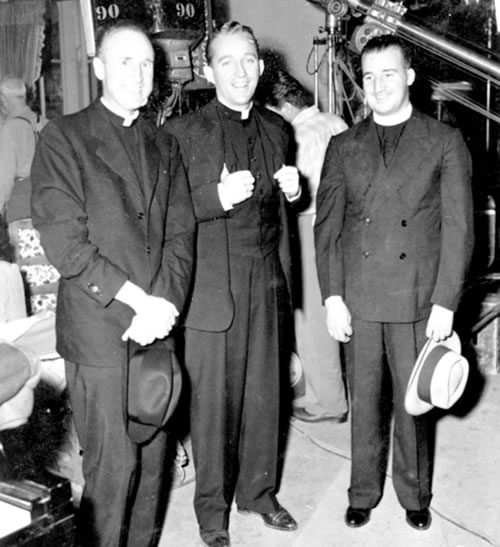
Columban Fr. Richard Ranaghan (1889-1937)
Richard Ranaghan was born in Killough, Co. Down, Ireland, in 1889. He was ordained in 1914 and ministered in the Diocese of Down and Connor until he joined the Missionary Society of St. Columban in 1917.

He worked initially in The Far East magazine (the magazine of the Columban missionaries) offi ce in Ireland. In 1918 he went to the U.S. to do promotion work. In preparation for travel to China in 1920 he bought a motion picture camera. At that time motion pictures were still at a very early stage of development. Although funds were scarce, he received encouragement from Columban Superior General and Society cofounder Fr. John Blowick who wrote to him on June 5, 1920: "Be sure to get the movie camera and as much stuff for it as you can. It will be worth the little cost and the trouble." Fr. E. J. McCarthy, the Columban director in the U.S., provided the $600 required for the equipment.
Fr. Ranaghan was a member of the fi rst group of Columbans who went to China in 1920. The boat journey to China provided him with t he fi rst opportunity to record Columban life on motion pictures. Following Fr. Ranaghan's arrival in China, Fr. McCarthy wrote to him from the U.S. about "making history with the camera." Two years later, presumably following positive developments with his fi lm clips in the U.S., Fr. McCarthy continued his encouragement by writing, "The motion picture is the greatest means we have for propaganda. Nothing to beat it…it brings China home better than a year's reading of The Far East magazine."
From 1920 to 1924, Fr. Ranaghan used more than 4,000 meters of fi lm to record life in China. His recordings included the experiences of Columbans and the lives of Chinese people in both rural and urban settings. This includes rare footage of a procession of bishops in front of St. Ignatius Cathedral, Shanghai, during the 1924 Synod of Bishops.
Pope Pius XI declared 1925 to be a Jubilee Year in the Church. During that year a missionary exhibition was held in Rome. Many missionary communities, including the Columbans, had displays at the exhibition. Fr. Ranaghan was responsible for the Columban display and showed visitors his motion pictures about the Church's mission in China. These fi lm clips, the only ones of their kind at the exhibition, were a unique attraction and even attracted favorable comments from Pope Pius XI.
Following the missionary exhibition in Rome, Fr. Ranaghan went to the U.S. where he continued his involvement in promotion work, relying heavily on the use of fi lm clips to communicate an understanding of the Church's missionary outreach in China.

In the early 1930s Fr. Ranaghan began to edit his film material. In cooperation with Fidelity Production Co. of New York, a film named "Heralds of Dawn" was produced. The film was released on December 21, 1932. Columban funds were scarce at the time due to the economic depression in the U.S. However, Columban priests contributed their own money towards the production of the film, which cost $800. Unfortunately, we do not have a copy of that film. Fidelity Production Co. is no longer in existence. Presumably it was taken over, along with its archives, by a larger film company, a common event in the early years of the film industry.
By the mid-1930s technology had developed to the point where it became possible to have motion pictures with recorded sound. At this time Fr. Ranaghan began work on producing a new film named "Cross and Dragon." It is a clever piece of film production because it has footage from the early 1920s with appropriate sound added for people's voices and street music as needed.
Suggestions were made at the time that it would be good to have sacred music as part of the film. Fr. Ranaghan met a relatively unknown young singer named Bing Crosby who agreed to sing a number of hymns with well-known band leader, Guy Lombardo, for the new film. Bing Crosby believed that the hymns should be recorded onto a vinyl disc and sold during mission promotion events. One of the hymns on the vinyl disc, but not in the film, is "Silent Night." This is Bing Crosby's first recording of the hymn that later became one of his trademark pieces.
Film reel material used in the early years of motion picture was chemically unstable and therefore difficult to preserve for long periods of time. Unfortunately, the majority of Fr. Ranaghan's film archive deteriorated over time. The footage contained in "Cross and Dragon" is of a high quality. It shows Fr. Ranaghan's skills as a filmmaker, particularly his understanding of panning the camera while recording, a technique that remains important in modern filmmaking. Apart from his creativity in being a pioneer of motion pictures, the narration by Fr. Ranaghan also shows his great belief in the Church's mission in China as well as his deep love for the Chinese people, whom he describes as being "made in the image and likeness of God."
Fr. Ranaghan died when his car skidded off the road on October 20, 1937, while returning to the Columban House in Omaha following promotion work in Iowa.